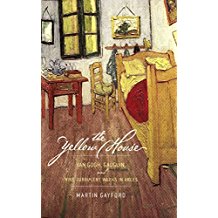The Yellow House: Van Gogh, Gauguin, and Nine Turbulent Weeks in Arles, Martin Gayford, 2006
Gayford, a British art critic, chronicles the time from October 22, 1888 through Van Gogh’s breakdown on December 23 when he cut off his ear and was hospitalized for the first time. The excitement of this period in art history is well captured as are the characters of the two painters, each challenging the establishment and seeking to incorporate the breakthroughs of Impressionism in their own manner. Van Gogh, a 35 year old Dutch painter who had yet to sell a single canvas, moved to Arles (no one knows how or why he chose that town) in order to create an artists’ colony, a Studio of the South where the light, the climate, and the pace were different from Paris and his native Holland. A chronic failure at art dealing (a family business), preaching in Belgium, teaching in England, and a failure in love (repetitive rejections by inappropriate women he courted), Van Gogh rented the Yellow House and created studio and living space while on a stipend from his younger brother Theo. Gauguin, born in Peru and a successful stockbroker with five children and a Danish wife whom he abandoned to paint in Martinique, joined Van Gogh from Brittany at the urging of his patron, Theo. The two men painted and collaborated, but were a toxic mix. Gauguin had a gigantic ego and Van Gogh was clearly bipolar. Within 2 years of their abortive attempt to build a colony of the South, Van Gogh was dead of a suicide and Gauguin had decamped for Tahiti. A challenging book because of its non-linear chronologic style, yet fascinating insight into two great artists.



